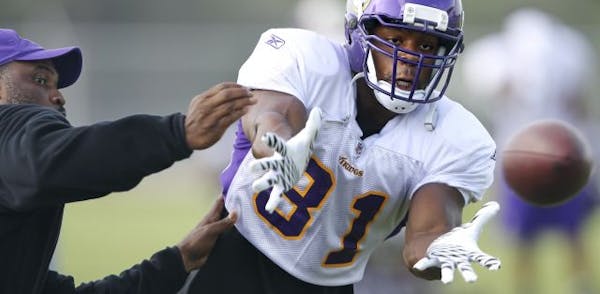As an NFL rookie in 1999, Antoine Winfield just assumed he was required to wear pads on his legs as he was in college. That was until he looked around the Buffalo locker room and noticed many of the veteran defensive backs wore pants without padding.
"I'm like, 'Doesn't anyone wear pads?'" Winfield recalled. "So I had to fit in. That's an ugly look. A cornerback with thigh pads and knee pads? I don't think you'll see one in the league."
It's certainly become a rarity, because players on both sides of the ball prefer a sleeker look. Few wide receivers and defensive backs wear any pads below the waist these days. Even some linebackers, including the Vikings' Chad Greenway, use a lightweight, streamlined version of thigh pads.
The two most popular reasons are speed and fashion appeal. Players feel less restrictive without pads on their legs, thus making them feel faster, even if the benefit is more psychological than truth.
Others simply subscribe to the "look good, play good" theory. Whatever their reasoning, players say they're willing to deal with an occasional deep thigh bruise in order to keep their legs free of pads.
"I've never worn any pads on my legs since I've been in the league," Arizona Cardinals All-Pro wide receiver Larry Fitzgerald Jr. said. "It's all about speed, especially for a guy like me who's already not fast enough."
Now in his 13th season, Winfield also has never worn leg pads and isn't about to change.
"It's all mental," the Pro Bowl cornerback said. "We all think it makes us faster, but it's the look. You want to get out there with your uniform looking nice. You don't want big pads. That's not a good look."
Greenway, the team's leading tackler the past three seasons, only wears a thin piece of hard plastic over the "meat of the muscle" on his thigh. Wide receiver Jaymar Johnson detests leg pads so much that he rigged his pants in college to make it look like he was wearing them. Others also rejoiced in being able to shed them officially once they made it to the NFL.
"It is very Pop Warner-ish," Vikings wide receiver Bernard Berrian said. "They don't really do anything, that's the whole thing. It's really not that much of a protection."
The NFL changed its uniform policy in 1995 and only recommended that players wear thigh, knee and hip pads. Previously, those pads were mandatory. The rule change gradually caused leg pads to become obsolete among some positions.
ESPN reported in January that the league's competition committee would consider a recommendation to owners that would make thigh and knee pads mandatory again. However, a league spokesman said that discussion was tabled, and it seems highly unlikely any change is forthcoming. The players union undoubtedly would fight that proposal hard.
"Even if they try and make us wear them, I think a lot of people still won't," Johnson said. "They'll just accept the fine. I'm not wearing those things."
The NFL views it as a safety issue. The league has made tremendous strides in its education and awareness of concussions. Helmet technology has improved and the culture of diagnosing and treating players suffering from concussion symptoms stands in stark contrast to yesteryear.
However, it would be nearly impossible for the league to track leg injuries that occur because players are not wearing pads. Many players don't miss any game action because of that type of injury. Vikings head athletic trainer Eric Sugarman was not available to comment for this story, but his staff deals with a number of thigh bruises every season.
Second-year cornerback Chris Cook admits he suffered a thigh bruise in the New England game last season after he fell on an opponent's leg. Cook also had arthroscopic surgery on both knees to repair torn meniscus. He indicated in training camp that he is leaning toward wearing both thigh and knee pads this season as protection.
"I'd rather be safe than sorry," Cook said. "They don't even restrict you or anything. It's just about looking good basically. The pads, I don't even think they're half a pound. It won't bother me much."
Pads viewed as ineffective
The NFL is working with equipment manufacturers to produce apparel with thigh and knee pads already inserted and is worn under uniform pants. An NFL spokesperson said some players are wearing them this season and the league is testing their effectiveness.
Players argue that pads won't prevent serious injuries, especially ones involving their knees.
"If a guy hits you here [outside of the knee], your leg is going to go regardless of whether you have a pad on or not," Fitzgerald said. "[A pad] means nothing. A charley horse, I'll be able to work through."
Wide receivers and defensive backs also contend that -- unlike running backs -- they are not as susceptible to serious thigh injuries because of the nature of hits they endure.
"As a cornerback you shouldn't really get hit in your thighs," Winfield said. "You should be able to move and all that. We will get cut from time to time and might get kicked on a tackle."
Coaches around the league likely have little sympathy for players who suffer leg injuries because they weren't wearing pads. Vikings coach Leslie Frazier played during an era when pads were required, but he understands that's not in vogue these days.
"A lot of it is the look," Frazier said. "They know the safety ramifications, but it's a certain look they're trying to get."
Gordon, Jokic lead the Nuggets to the brink of a sweep with a 112-105 win over the Lakers in Game 3
Twins bring momentum into next series despite Angels Stadium struggles

Five home runs, including two by Julien, power Twins past White Sox

